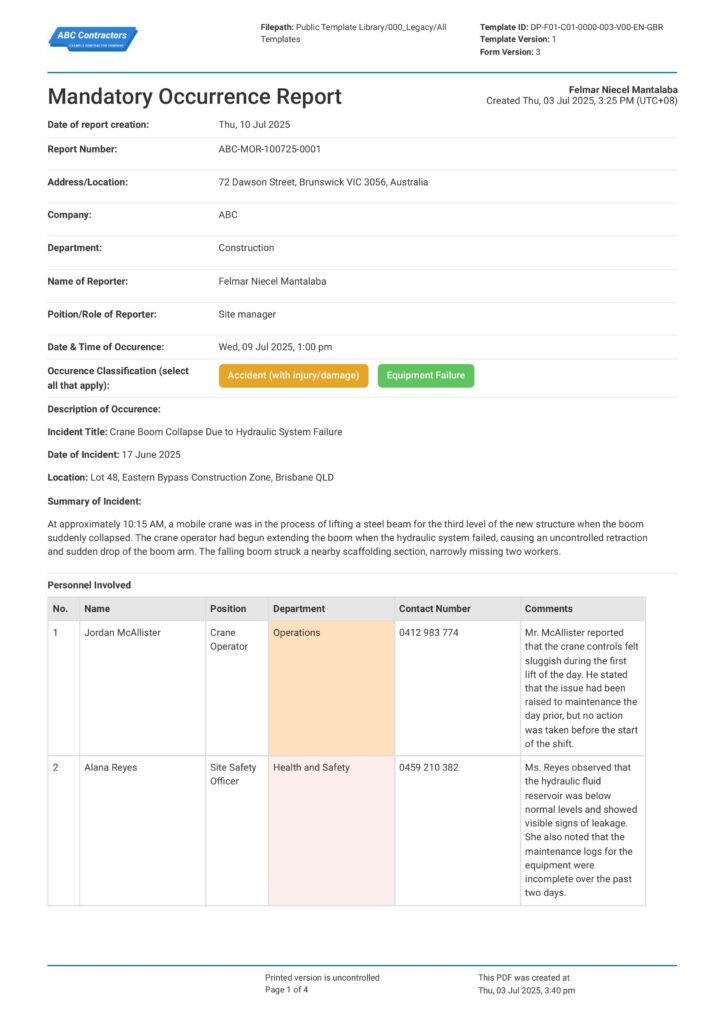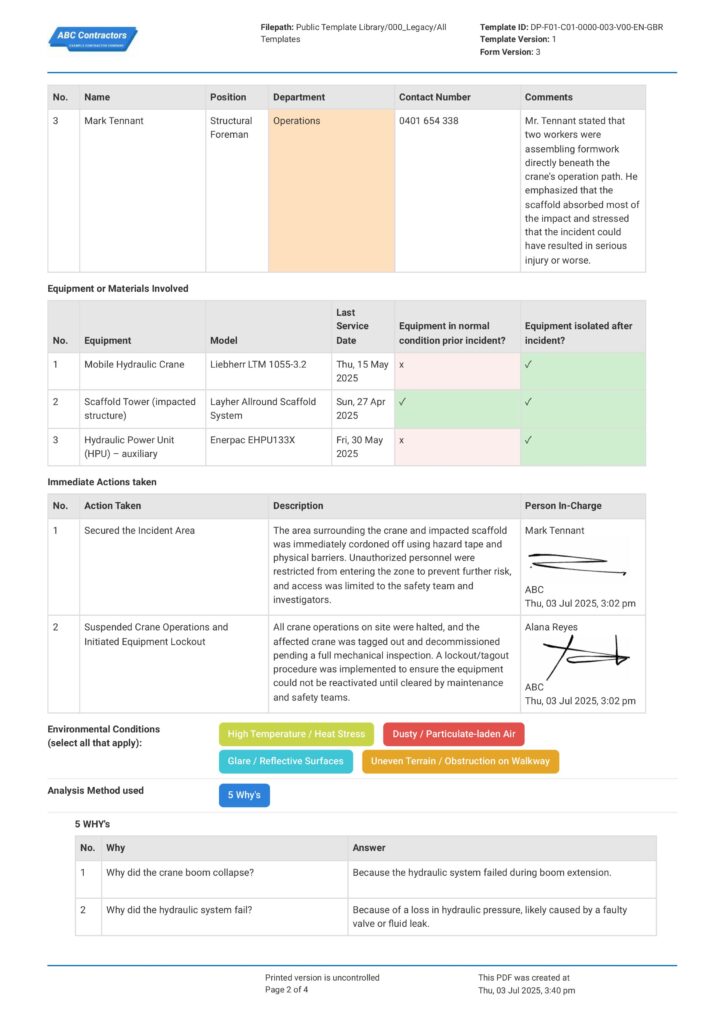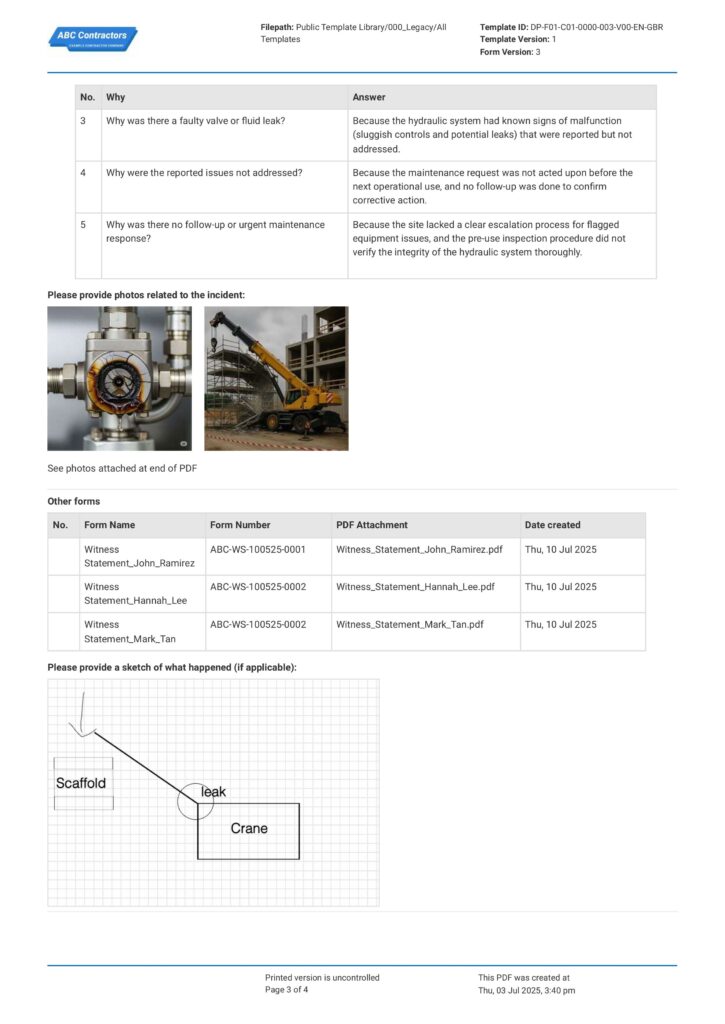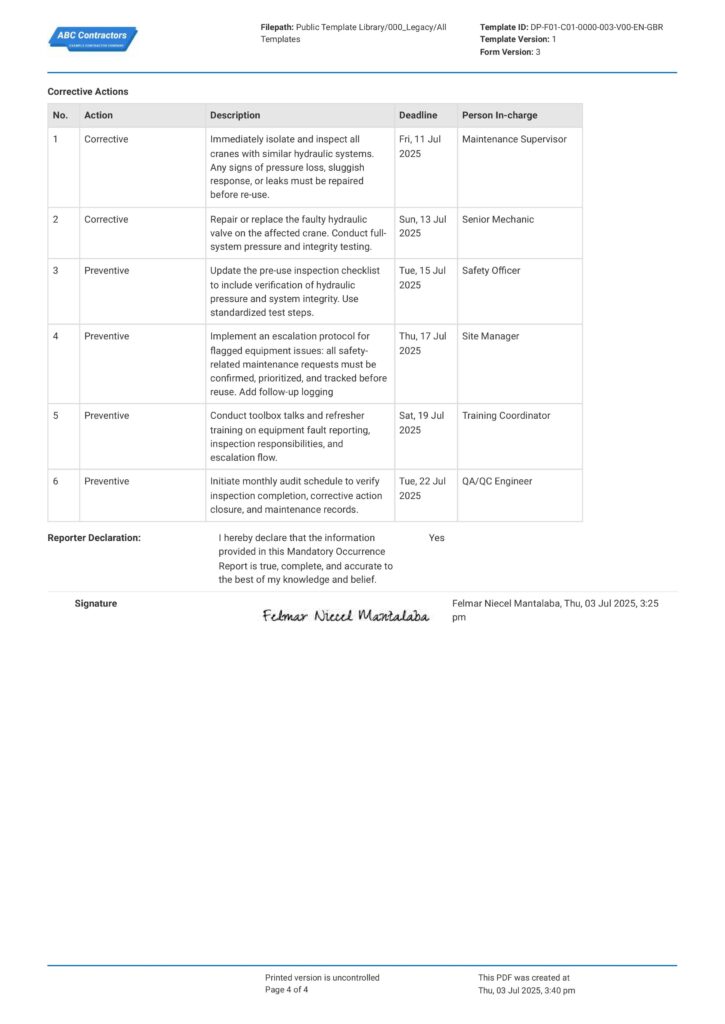Article Page – Mandatory Occurrence Report (MOR) Definition
Mandatory Occurrence Report (MOR) Definition
The Building Safety Act of 2022 now requires a Mandatory Occurrence Report (MOR) for managing and constructing higher-risk buildings. This article will help break down what an MOR is and offers a format and other free resources and guides to help you strengthen safety in the workplace.

Table of Contents
Article Summary
- The Building Safety Act of 2022 mandates that higher-risk buildings should implement a Mandatory Occurrence Reporting system to ensure that occupants and residents of these buildings are continuously protected from safety-related hazards.
- To ensure compliance and completion of the MOR, the principal accountable person, other accountable person, principal contractor, and building safety regulator must attend to their roles and responsibilities.
- The MOR is such a successful document in improving safety systems that it is widely used in the following high-risk industries: construction, aviation, the rail industry, and maritime.
Why is a Mandatory Occurrence Report (MOR) important?
A Mandatory Occurrence Report is important because it is a regulatory requirement in the United Kingdom. It is mandated in the provisions of the Building Safety Act of 2022 that businesses—especially those managing and constructing high-risk buildings—should report any incidents that occur on their premises to the regulatory authorities to avoid any legal charges.
The Building Act of 2022 was actually made because of a tragic incident. Before this act was made, no person was legally responsible for keeping a building safe once construction was finished. Because of the absence of safety management procedures, a tragic fire occurred in the Grenfell Tower, Lancaster West Estate, North Kensington, London, and claimed 72 lives on June 14, 2017.
Aside from being a regulatory requirement, the MOR also helps solidify existing control systems. Creating a Mandatory Occurrence Report (MOR) helps identify overlooked hazards and provides appropriate measures to eliminate them. Implementing this system with a proactive method of identifying hazards strengthens overall safety management and encourages workers to take initiative in reporting unidentified hazards in the workplace, which helps in managing risks before they escalate into something much more serious.
The Golden Thread UK Building Safety Act is an information strategy and a method that ensures compliance with the UK Building Safety Act. In addition, the MOR acts as as a source of information and data following the Golden Thread of Information strategy, which also serves as evidence for a Building Safety Case Report.
What format should an MOR follow?
An MOR is a formal document that needs to be submitted to the building safety regulator (BSR). Because of this, the MOR should be structured in a format that is purpose-driven and contains all factual information about its intent. To achieve this, the MOR must be thorough in capturing all vital details about the building and its safety systems, all identified hazards in a building, and the controls provided to mitigate the hazards.
By adhering to this structure, you can meet all regulatory requirements and guarantee the consistent safety of your building. To have a better understanding of how the MOR should look, study the example below to better grasp the idea of its format, content, or expected level of detail.
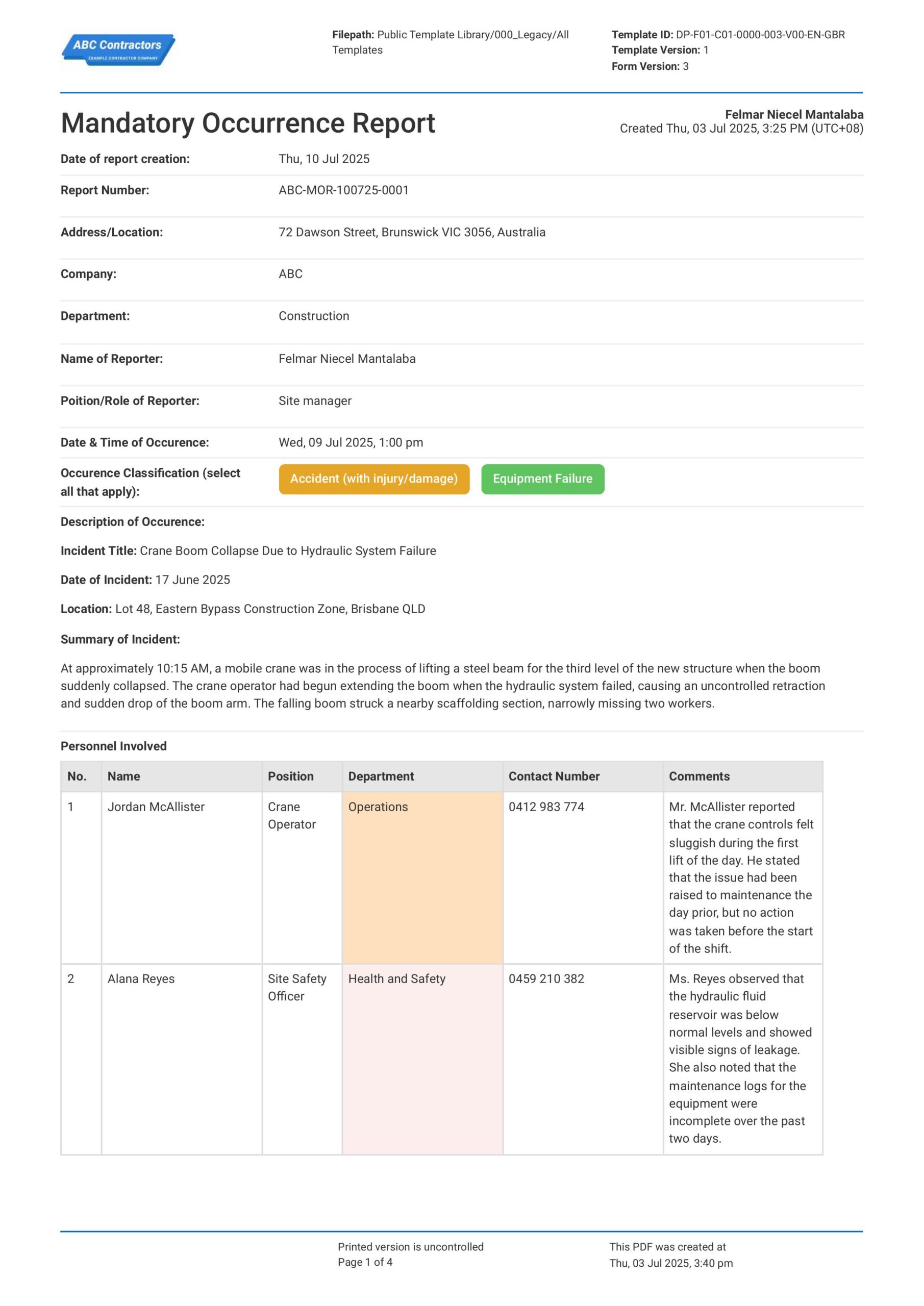
Use this Mandatory Occurrence Report for free
What is an MOR?
An MOR, or Mandatory Occurrence Report, is a document for reporting incidents, which is required by the UK government under the Building Safety Act of 2022, section 87. The provision says that an accountable person for an occupied, higher-risk building is mandated to implement a Mandatory Occurrence Report system. The goal of this system is to ensure that any potential threat to the safety of the inhabitants and structural integrity of the building must be reported to the Building Safety Regulator (BSR).
The MOR can assist in creating a stronger building safety system. Enforcing discipline and consistency in keeping every activity, method, and job free from dangers may be improved by the careful examination of safety concerns and the heavy obligation imposed on duty holders. This can encourage a proactive attitude in detecting workplace dangers and strengthens the idea that safety comes first. The MOR is a cornerstone for ensuring safety in every workplace in addition to being a regulatory document.
Roles and responsibilities in the MOR System
There are certain roles and responsibilities that need to be appointed to effectively implement the MOR system. Certain personnel must be appointed to accomplish all the necessary tasks associated with identifying, reporting, managing, and reviewing occurrences. These duty holders are the following:
Principal Accountable Person (PAP) -
The principal accountable person has the greatest responsibility in the MOR system. This person is the main duty holder who is tasked to create and operate the Mandatory Occurrence Report system and submit all MORs to the BSR. The principal accountable person is responsible for overseeing the MOR investigations, which are formal processes of reviewing incidents and formulating concrete controls, and for conducting frequent MOR inspections to ensure that all existing controls remain effective. Ultimately, their responsibility ensures that the system is effective in managing risk and adheres to regulatory compliance.
Other Accountable Person (AP)
These accountable persons are the hands and feet of the principal accountable person. Most of these people are assigned to certain areas, floors, or sectors of the building to identify and respond to safety risks. This procedure ensures that no reportable event goes unnoticed. However, it must be understood that APs are not legally obliged to submit the MOR. Their only role is to support the PAP by providing evidence, descriptions, and supporting details for the MOR.
Principal Contractor/Designer
Although the provisions of Section 87 of the Building Safety Act of 2022 apply to the occupancy phase of the building, there are equivalent reporting duties that the principal contractor or designer must perform during the design and construction phases. They also must report any incidents or occurrences that pose serious risks when the building is ready for occupancy. These reports are usually submitted during the construction and design phase of the building and must be continuously monitored during occupancy.
Building Safety Regulator
The Building Safety Regulator (BSR) oversees building safety and standards, maintaining compliance, with special emphasis on high-rise structures (exceeding 18 meters or seven stories) and other designated 'higher risk' buildings. His major responsibilities are to obtain and evaluate mandatory occurrence reports and notifications from the principal accountable persons and principal contractors, make sure that all safety occurrences are correctly addressed, and improve the overall safety of higher-risk buildings. Overall, the BSR plays a large part in ensuring that a building is continuously safe throughout its lifecycle.
Where is the MOR Applicable?
There was a survey conducted in the UK that asked workers about their experiences with the implementation of the MOR. 80% of the respondents said that the MOR should be part of the requirements when applying for a Building Safety Certificate. This means that both workers and residents have confidence in the MOR system to ensure a safe working and living environment. To prove this statement, let’s look at other industries that have integrated the Mandatory Occurrence Report System.
Building Sector - Mandatory Occurrence Report (MOR) Definition
The Building Safety Act of 2022 has placed a mandate that high-risk buildings—those that are 18 meters tall, have at least 7 stories, and include 2 residential spaces—must implement a Mandatory Occurrence Reporting System. The goal of the act was to ensure that any safety risks—like fire and structural safety issues—in the building are found and reported early before it escalates into something disastrous. With the system implemented, it imposes strong accountability and reassures residents that they are always safe.
Aviation
The aviation industry maintains high safety standards because even a small mistake can lead to catastrophic events. In fact, the aviation industry was the first to adopt the MOR system. They use the MOR to report plane equipment failure, near misses, and even human error. Their goal was to collect data on all events that compromise safety (even if no one was harmed) and use this data to further improve their safety system. Such a proactive approach has ensured safe flights all over the world, leaving customers confident with their safety when they travel in the air.
Rail Industry
The rail industry is another high-risk industry. The large passenger volumes, heavy machinery, and complex infrastructure open a lot of room for potential hazards, which can lead to tragic events. Because of this, the rail industry has employed the MOR system to improve response time to mechanical failures and prevent any operational errors and collisions. The report also helps contractors discover patterns, allowing them to provide solutions for any identified gaps. This helps ensure passenger safety by actively highlighting and correcting potential safety risks.
Maritime
Being on a ship, isolated in the middle of the sea, can be troubling, especially if incidents arise that could potentially harm someone or take their life. It is of utmost importance that these risks are easily identified and immediately provided with measures to prevent them from escalating. The MOR serves as a record of lessons and experiences that could be handed from one ship to another, which helps seafarers become aware of hazards that they have yet to identify. This ensures a strong safety standard across all maritime establishments.
Addressing safety incidents the smart way
Although incident reports—like the MOR—are designed to address safety hazards at a faster pace, the process of completing them can be tedious and lengthy, particularly when paper-based forms are used. The physical handover of paper forms between individuals, delays in manual entry, and the absence of real-time visibility all hinder its timely completion. And let us not forget how paper-based are more prone to human error, which could negatively alter the results of the needed solution for identified hazards. It would just be ironic to make safety more efficient in an inefficient way.
However, with the Incident Report Software, you can now streamline how incident reports are accessed, documented, arranged, and tracked to improve worker safety and safety compliance. You can produce reports, analyze trends, collect incident data, and conduct investigations with ease thanks to tools that automate your whole process. In addition to saving you valuable time, the procedure guarantees that regulations are followed, ensuring your compliance and safety at all times.
Summary of Mandatory Occurrence Report (MOR) Definition
The MOR is a regulatory requirement under the Building Safety Act of 2022 that the building sector should comply with. It assists in creating a stronger building safety system and enforces discipline in keeping every corner of a high-risk building free from dangers. The MOR achieves its objective by carefully examining safety incidents and providing appropriate measures to eliminate them. With a structured and systematic reporting framework, the MOR eliminates the possibility of any safety-related incident and creates a culture of accountability, ensuring protection for both inhabitants and workers.
Frequently Asked Questions
Does the MOR requirement apply to all existing buildings in the UK?
Yes, the MOR (Mandatory Occurrence Reporting) system is required for certain existing buildings in the UK — specifically those classified as "higher-risk buildings" under the Building Safety Act 2022. This mainly includes high-rise residential buildings that are at least 18 metres tall or have 7 or more storeys, and contain at least two residential units.
How is technology transforming the way occurrence reports are conducted?
Technology is transforming how people handle occurrence reporting by moving away from slow, paper-based processes and shifting to smarter digital platforms like Dashpivot. Instead of manually filling out forms and chasing signatures, teams can now log incidents on-site using mobile devices, automate parts of the reporting workflow, and standardise documentation across projects. The result? Faster reporting, fewer errors, stronger compliance—and a clearer picture of what’s really happening on the ground, leading to safer, more efficient worksites.
Does Sitemate offer other templates for incident investigation?
Yes - Sitemate offers ready-to-use and editable Incident Investigation Report template that can also be edited for your workflow. Companies of all sizes and across various industries are already using these templates to streamline the investigation process for workplace incidents, near-misses, and accidents.
Related resources
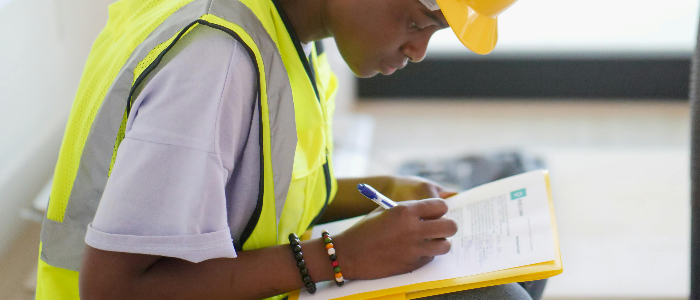
Building Safety Case
Record multiple hazards and elements required under the UK Building Safety Act.

Building Envelope Inspection Checklist
Detail and log issues and concerns of the building envelope with this inspection checklist.

Progress Claim template
Easily inspect building foundations with a complete and fully editable template.
